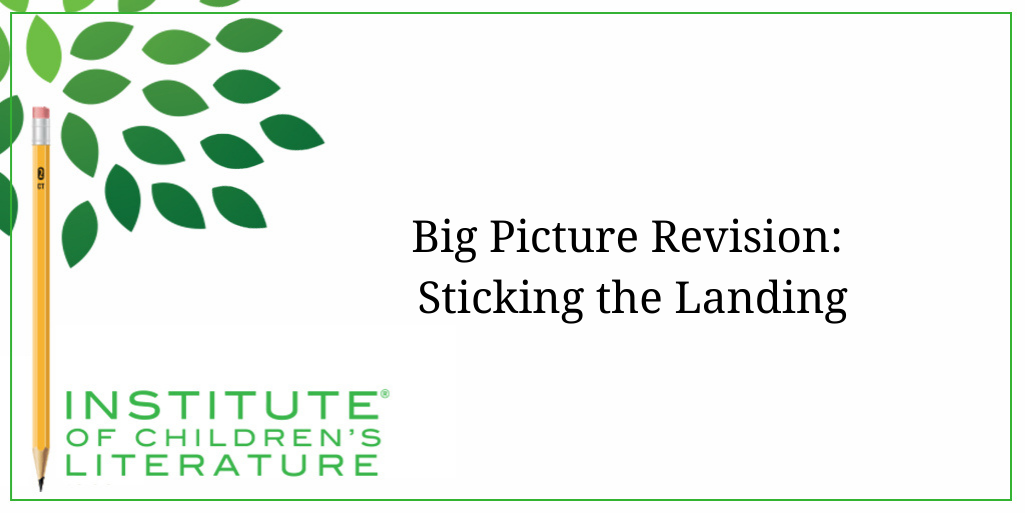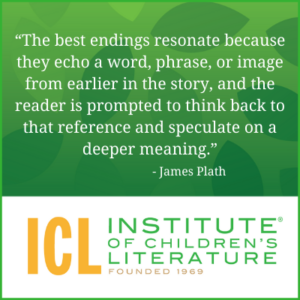
5 Ways Writers Can Prep for 2025 Goal Setting
Before we roll on to the new writing year, let’s harness our optimism for the blank slate before us and prepare for our 2025 Goal Setting just for writers.

We teach our students how to write and get published!
View our Course Catalog >
It’s easy to underestimate the importance of the perfect ending. It brings everything that came before it to a satisfying end. If done well, it leaves the reader still thinking about the story, article, or book. The perfect ending is far more than simply the point where the writer stops writing. It is the point where everything you’ve written before pays off. As such, the ending deserves as much attention during the revision process as the beginning.
One of the words used most often to describe a really good ending is “satisfying.” A good ending satisfies. It makes it clear how everything that has come before has led to this point. In fiction, it shows transformation. In nonfiction, the ending brings together everything that came before, making it clear exactly what the point of the article or book has been. Many times, it will also echo the opening in some way to give a sense that the beginning and ending are related. In both fiction and nonfiction, it clears up any straggling questions that weren’t better answered elsewhere—and it does it with style.

Another enemy to good endings is the fiction ending that simply stops without any real payoff to the story. In Save The Cat! Writes a Novel, Jessica Brody talks about the ending as the Final Image, and says, “If the Opening Image was the before snapshot (of your characters and their situation), then the Final Image is the after snapshot.” In other words, the ending is where you “show us what your hero looks like after this epic transformative journey is complete.” In old-fashioned fairytales, endings were often a kind of summation of what the character learned or what the character should have learned, and that certainly plays a part even in endings today, but today we generally avoid any kind of ending that simply blurts out a lesson. Instead, we show the character as a changed person because of the events that came before. Now if you’re writing a children’s short story or a picture book, the journey might not seem that epic. However, it should be epic for the character, otherwise, the story will feel shallow and the ending will not satisfy.
Another enemy of a satisfying fiction ending is when the end result is unearned or when it has nothing to do with the actions of the main character. This is distressingly frequent in children’s fiction when writers get their characters into deep trouble and then send someone in to fix it. It can also happen when the ending is inevitable.
For example, suppose your main character is desperately wishing for a dog. One day she decides to prepare a full-on campaign to present to her parents when they get home. She cleans the house to perfection. She jumps on her homework instead of giving in to the urge to play computer games. She even makes a special bed for the dog she intends to ask for out of old boxes and a tattered pillowcase. Then she prepares her presentation about why a dog would be a helpful addition to their home, complete with posters for visual aids. Finally, she is ready and waiting as her parents come through the door, carrying the dog they bought that day. In a story like that, the ending is certainly happy, and the main character may not even care that all her work was for nothing but the reader will care. The reader won’t feel satisfied by the ending that would have come out that way no matter what the main character chose to do. The surprise of the ending is not enough to be satisfying when it doesn’t come about from the story you’ve told.
Whether fiction or nonfiction, the ending of your work will always come from what has already been said. In fiction, it will also grow from what has been felt before. Fiction is emotional stuff, so a satisfying ending will work both logically and emotionally when viewed with all that came before. Sometimes the best ending requires some revision of either the ending itself or of what came before in order to be all that it can be. In nonfiction, it can mean tweaking your opening so that your ending lines can mirror some element of the opening while still bringing the different ideas and information of the piece together in a satisfying way. In fiction, it can mean re-examining any hints you’ve made about where the story is going and being certain that they point correctly to where you actually go.
Of course, in some fiction, you may choose to intentionally misdirect the reader, and that’s part of the fun. In mysteries, for example, you’ll often try to make the reader believe you’re going to come up with one solution when, in reality, you take them somewhere different. But those are intentional actions. What you want to correct in your revision is unintentional action, places where you thought you were going somewhere, but the story took you somewhere else. During revision, the end that you come up with must have had portents and signals in terms of theme, action, or emotion throughout the story. Otherwise, the ending will feel as if it came out of the blue and the reader will not be satisfied.
Every fictional story and every nonfiction article will end with a final sentence. This last line is your final commentary on what has come before. It will reflect the overall piece in terms of tone and voice. For example, if your overall science article is very serious, the last line is probably not the place to crack out your witty pun, even if it’s a good one. At the same time, if your tone has been light and fun, the last line is often clever and whimsical, while also working with everything that came before.
Fiction also abides by similar rules. Your last lines will reflect the story overall in tone and emotion. Author Andrew Porter says, “The main thing I’m thinking about when I get to the end of a story is how to end with a line or a piece of dialogue that will resonate emotionally with the reader.” This is because endings do more than reflect the emotional journey of the characters, they also bring the reader to the end of the emotional journey they’ve been on. The reader hasn’t always felt the same thing as the characters, but in a strong story, they have felt something. So, you want to create a last line to make the reader smile or laugh or prick the reader’s heart. Something that has emotional weight.
Many times, revision can be exhausting. Sometimes we lose a little of our energy and oomph by the time we get to the end. This can lead to not paying the ending the attention it needs. You may want to take a break and come back to revising the ending all its own when you’re fresh and ready to view what you’ve written through a critical lens. Don’t be afraid to do a little work to revise and craft the perfect ending. Readers may have been lured to read your book or story or article because of your amazing opening, but they’ll leave the piece wishing they could read more by you if your ending is worth the wait. Be the kind of writer that readers seek out by polishing your endings until they shine, satisfy, and leave the reader with something that lingers.
It’ll be worth the work. I promise.
With over 100 books in publication, Jan Fields writes both chapter books for children and mystery novels for adults. She’s also known for a variety of experiences teaching writing, from one session SCBWI events to lengthier Highlights Foundation workshops to these blog posts for the Institute of Children’s Literature. As a former ICL instructor, Jan enjoys equipping writers for success in whatever way she can.

Before we roll on to the new writing year, let’s harness our optimism for the blank slate before us and prepare for our 2025 Goal Setting just for writers.

Writers can be thin-skinned when it comes to getting feedback on their work. Let’s look at 4 ways to positively deal with constructive criticism!

Rejection is part of the territory when it comes to being a writer. Today we offer reflection for writers to help redirect your efforts after a rejection.
1000 N. West Street #1200, Wilmington, DE 19801
© 2024 Direct Learning Systems, Inc. All rights reserved.
1000 N. West Street #1200, Wilmington, DE 19801
© 2024 Direct Learning Systems, Inc. All rights reserved.
1000 N. West Street #1200, Wilmington, DE 19801
© 2024 Direct Learning Systems, Inc. All rights reserved.
1000 N. West Street #1200, Wilmington, DE 19801
© 2024 Direct Learning Systems, Inc. All rights reserved.

1000 N. West Street #1200, Wilmington, DE 19801
© 2025 Direct Learning Systems, Inc. All rights reserved.

1000 N. West Street #1200, Wilmington, DE 19801
©2025 Direct Learning Systems, Inc. All rights reserved. Privacy Policy.
8 Comments
As usual Jan, I am in awe of your constant flow of advice and its delivery. Thanks again for making me think.
Lorraine
Thank you, Lorraine, for your kind words and I’m so glad you found the piece thought-worthy.